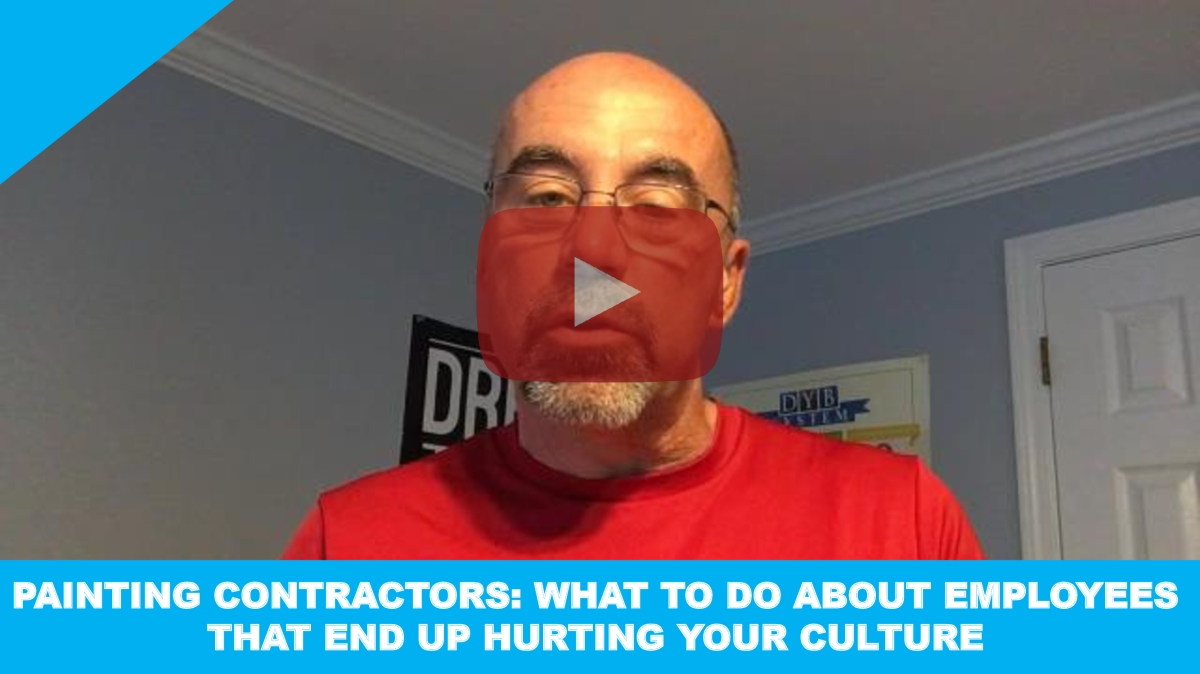
Painting Contractors: What To Do About Employees That End Up Hurting Your Culture
Do you have one of those employees who are really below the line?
They are late all the time and they have excuses for everything.
Don’t be fooled, they are actually hurting the culture of your business. They might be great workers, but they are not good for your company.
We’ve all heard the age-old saying, “One bad apple can spoil the whole bunch.” This is also true for your company. I know, it can be hard to let go of a hard worker, especially during the busy season, but let’s not take the easy way out.
If you have been around DYB, you have heard us talk about “Above The Line” and what it is. For those who are new, it’s making sure we all take ownership and accountability for our actions and never give excuses. We can teach our team this same philosophy and it’s very powerful.
I’ll share how to deal with these employees, but first, two examples.
Download Your FREE Checklist...
11 Interview Questions For Hiring All-Stars, E-mailed to you NOW!

Example One
We had one male employee who kind of liked one of the females and she wasn’t interested in him, but he bothered her and he bugged her and bugged her. It got a little out of hand and she called me one day. She said, “Hey, listen, I can’t work like this.”
That was my first experience with something like and I knew I had to take this by the horns.
I talked to a lawyer who is in one of my networking groups. He said, “You have to confront both parties separately. Then, if they want to talk, you can be the mediator.”
That wasn’t going to happen in this situation.
The lawyer continued, “Then you have to make sure that someone owns up to it or at least acknowledges the conversation.”
I went to the female, talked to her for a bit, and then I confronted the male. In this case, I did have a witness. I brought one of the crew leaders who knew him well, into the conversation. He kind of knew what was going on anyway.
I didn’t know how the offender was going to handle this.
We had the conversation and he denied everything. I told him he had to at least sign a paper that said that we had this conversation and he said he wouldn’t sign it if he was admitting to guilt. I told him it wasn’t about admitting to anybody’s guilt, it was admitting that he and I had this conversation.
A couple of weeks later, everything seemed to be okay. They were working together on a job and then it happened again.
Well, that’s strike two. We had the same conversation and then we separated them into different crews, so they didn’t work together anymore. That kind of solved the problem.
What would you do in this situation?
Example Two
Allow me to give you another example.
We had a crew leader who had one of our trucks.
He was continuously late, excuses every time, and it went on and on and on.
I don’t know a contractor who hasn’t heard some or all of these excuses at one time or another from an employee.
Maybe for you, it was someone who has excessive absenteeism for no reason. Maybe they are late on Mondays, the day after payday, or they don’t even come in the day after payday and they have different excuses each time.
Well, if you’re experiencing the same challenge, here is what you can do about it.
Create an Employee Handbook
If you don’t have an employee handbook, DYB can help, but you need an employee handbook.
When you have an employee handbook, have them read it and sign the last page, acknowledging and verifying they read it and will abide by the company policies inside.
Doing this when you hire them and before their feet ever hit a job site, is paramount.
That way, when there is a violation of a rule, you can let the handbook discipline them and you’re not the bad guy – just point to the rules in your conversation with them.
You can include whatever you like in your employee handbook. It could talk about cell phone policies, truck policies, absenteeism, earned time with vacation time, sexual harassment, and much more.
These are your rules for your company. It not only makes a culture of employees that you want to work with, it makes a company that employees will want to work for.
If an Employee Violates the Agreement, Have a Conversation with Them
After the initial issue, have a conversation with the person.
Remind them that this isn’t good for the company, it goes against company policy they signed, and you can refer to the employee handbook section they violated.
Have an Employee Sign a Warning for Repeated Infractions
When the said employee is late the next time, you have to write them up, and it can be hard.
I had a hard time writing someone up for small infractions, but I’ve got to tell you, small infractions can easily turn into very large infractions.
So, you would tell them that they were late, they had been verbally warned, this is their first written warning. Then they sign the written warning and then you sign it. Make sure you date it, also.
If they don’t want to sign it, you can just sign it and write, “Refused to sign,” then you date it.
Put this in their employee file in a secured place.
If that happens again, written warning number 2 is made just like number one.
If number 3 happens, we have a “3 strikes, you are out policy” –again this is in the employee handbook they signed.
If you have policies in your employee handbook and they are violating those, you have to write them up.
It is hard at first, but believe me, it is great for the culture of your company. Other employees will see how you take action and follow through with the company policies in the handbook and will take notice to be “Above the Line” and follow your company policies in the employee handbook.
Keep All the Signed Warnings in a Secure Place for Future Reference
If you do follow this system and you actually have to let someone go, you would have a history of why they were fired, just in case they go for unemployment and you want to contest the unemployment claim.
In some cases, the paperwork you have, including that they acknowledged this was a violation of the employee handbook, could cover you against claims.
Backed up by paperwork, you could save a lot of time and frustration.
Plus, employees would know that you mean business (in a good way) when it comes to maintaining the culture of the company.
1. Create and Use an Employee Handbook
2. Follow Through with Company Policy Disciplines
3. Keep Your Paperwork Safe (and backed up digitally)
That’s my little story about how to handle an employee issue, and keep the culture up in your company. My name is Ron Ramsden, painting contractor in MA and DYB Coach.
If I can help or if you have any questions, I would love to hear from you. Comment here or send me an email; I would love to hear about your employee issues and how you handled them. You can find me at Ron@DYBCoach.com.
Once again, if you need help with creating an employee handbook, we would be more than happy to help you.
